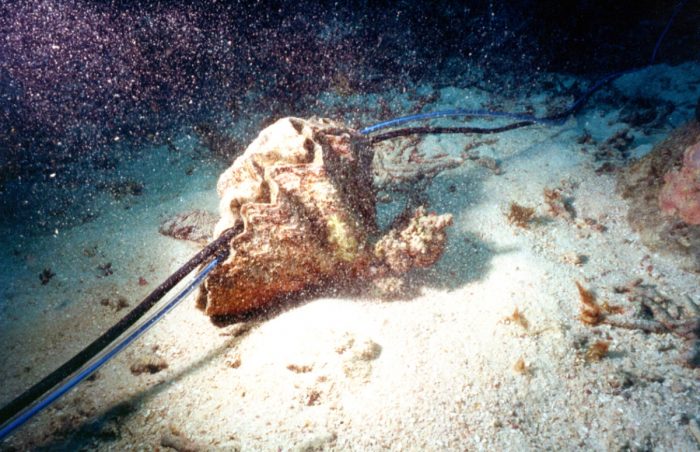Ocean Optics fiber optic transmission and reflection probes in Air and Water

Optical fibers and probes can be optimized for various environments, although we’re not 100% certain we can guarantee our fibers are giant clam-resistant. Photo by Ocean Optics
Ocean Optics fiber optic transmission and reflection probes are optical sampling systems that work in either air or liquids, depending on the assembly type and sample environment. Probe behavior changes when the refractive index of the media changes because the fibers and lenses in these systems are operating under Snell’s Law.
Optical fibers and probes are created to transmit light from one end of the fiber to the other with minimal loss of energy. When light passes from one material to another, its direction changes. According to Snell’s Law, the new angle of the light ray can be predicted from the refractive indices of the two materials.
The refractive index of air is approximately 1, while the refractive index of water (1.33) and organic solvents like ethanol (1.36) are considerably higher. We observe similar differences when considering Ocean Optics silica-core fibers, which have a numerical aperture of 0.22 and an acceptance angle of about 25° in the air. However, when the fiber is placed in water, the acceptance angle is reduced to ~19°.
Transmission Dip Probes
Ocean Optics transmission dip probes are designed for use in liquids. Our general-purpose T200 and T300 series probes comprise two fibers projecting light through a shared lens. Light from a source is focused by the lens onto a mirror across the sample gap. The light is reflected through the lens to the read fiber, which brings the light to the spectrometer. The lenses are focused for use in water, and if used in air, will be severely out of focus and inefficient.
Reflection Probes
Ocean Optics standard reflection probes are a comprised bundle of one fiber surrounded by six fibers, and can work in air or water, but with quite different performance. In the air, light exits the six illumination fibers in a 25° cone. The center read fiber accepts energy from a 25° cone. These cones overlap at a distance determined by the space between the fibers (usually 2x the cladding thickness) so that samples that fluoresce or reflect light will be detected in this overlap region. When used in water, the cones are only 19° and the overlap region is smaller and farther from the tip of the probe.
Efficiency of Fibers and Probes in Air Versus Water
A positive aspect of using fibers and probes in water is that the transmission efficiency improves. This is because the Fresnel reflection (r) at the interface between a fiber or lens (n1) and the media (n2) scales with refractive indices:
r = ((n1 – n2)/ (n1 + n2))2
In a silica-core fiber, the fiber to air loss of transmission efficiency is about 3.5%. In water, the loss is only 0.2%. An example of this benefit is the increase in the signal obtained using a reflection probe inserted into a liquid sample to measure fluorescence. The loss of excitation energy and fluorescence at the sample/probe interface is minimal. In comparison, there are eight air-to-silica interfaces in a standard cuvette-based system, leading to a 25% reduction in signal.
Other Considerations
There may be circumstances other than refractive index differences to consider when using fibers and probes in water versus air. For example, for irradiance measurements a cosine corrector can be screwed on to the end of a fiber, expanding the field of view to 180° and transmitting light energy to the fiber scaled to the cosine of the angle of the light. The cosine corrector works in the air but fails in water because it is not waterproof. If water contacts the fiber, the acceptance angle will change and the calibration of the system will be in error.
To ensure optimal performance of your fibers or probes, please consult an Applications Engineer. Depending on the application, some probes may not be suitable for use in liquids, in harsh environments or for measuring samples under pressure.
For more information, please visit oceanoptics.com
News Categories
- » NEWS HOME
- » Automation & Robotics
- » Industry 4.0
- » Material Handling
- » Sensors
- » Quality & Testing
- » Machine Vision
- » Laser & Optics
- » Metalworking
- » Motion Control & Drives
- » Hydraulics & Pneumatics
- » Process Industry
- » Renewable Energy
- » Agriculture
- » Home & Office Furniture
- » Environmental Tech









